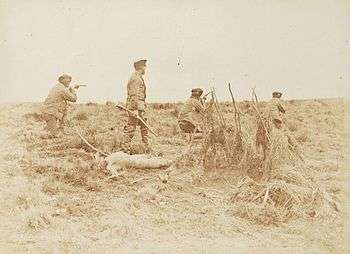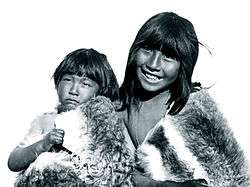Selk'nam genocide
| Selk'nam genocide | |
|---|---|
| Part of Genocide of indigenous peoples | |
 Julius Popper carrying out the genocide. | |
| Location | Tierra del Fuego, Chile |
| Date | late 19th to early 20th century |
Attack type | Genocidal massacre, Internment, Bounty killings |
| Deaths |
3,900[1] (97.5% of the population killed) |
| Victims | Selk'nam tribe |
| Perpetrators | Julius Popper and other head hunters |
| Motive | Utilitarian genocide |

The Selk'nam genocide was the genocide of the Selk'nam people, one of three indigenous tribes populating the Tierra del Fuego in South America, from the second half of the 19th to the early 20th century. Spanning a period of between ten and fifteen years the Selk'nam, which had an estimated population of some three thousand, saw their numbers reduced to 500.[2]
History
The Selk'nam are one of three indigenous tribes who inhabited the northeastern part of the archipelago, with a population estimated at between 3000 and 4000.[3] They were known as the Ona (people of the north), by the Yamana.[4] They were a nomadic people who survived by hunting and gathering, with the majority of the population centered on the Tierra del Fuego islands.[5]
The last full-blooded Selk'nam, Ángela Loij, died in 1974. They were one of the last aboriginal groups in South America to be reached by Europeans. According to the 2010 United Nations Educational, Scientific and Cultural Organization (UNESCO) Atlas of the World's Languages in Danger, the Ona language, believed to be part of the Chonan family, is considered extinct, as the last speakers died in the 1980s.[6]
The Selk'nam had lived for thousands of years a semi-nomadic life in Isla Grande de Tierra del Fuego (literally "big island of land of fire", its name being based on early Spanish explorers' observations of smoke from Selk'nam bonfires.) They lived in the northeast, with the Haush people to their east on the Mitre Peninsula, and the Yaghan people to the west and south, in the central part of the main island and throughout the southern islands of the archipelago.
About 4,000 Selk'nam were alive in the mid-nineteenth century; by 1930 this had been reduced to about 100. Cattle breeders, farmers and gold-prospectors from Argentina, Chile, the UK and the USA had entered the region, and were joined by adventurers and other fortune seekers. The natives were plied with alcohol, deported and exterminated, with bounties paid to the most ruthless hunters.[1] The large ranchers tried to run off the Selk'nam, then began a campaign of extermination against them, with the compliance of the Argentine and Chilean governments. Large companies paid sheep farmers or militia a bounty for each Selk'nam dead, which was confirmed on presentation of a pair of hands or ears, or later a complete skull. They were given more for the death of a woman than a man. In addition, missionaries disrupted their livelihood through forcible relocation and brought with them deadly epidemics.
Repression against the Selk'nam persisted into the early twentieth century.[7] Chile moved some Selk'nam to Dawson Island, confining them in an internment or concentration camp. Argentina finally allowed Salesian missionaries to aid the Selk'nam and attempt to assimilate them, but their culture and people were largely destroyed.
See also
References
- 1 2 Gardini, Walter (1984). "Restoring the Honour of an Indian Tribe-Rescate de una tribu". Anthropos. Bd. 79, H. 4./6.: 645–47.
- ↑ Chapman 2010, p. 544.
- ↑ Prieto 2007.
- ↑ Chapman2010, p. XX.
- ↑ Gilbert 2014.
- ↑ Adelaar 2010, p. 92.
- ↑ Adelaar 2010, p. 92.
Bibliography
- Adelaar, Willem (2010). "South America". In Moseley, Christopher. Atlas of the World's Languages in Danger (3rd Revised ed.). UNESCO. pp. 86–94. ISBN 978-9231040962.
- Prieto, Alfredo (2007). "The Struggle for Social Life in Fuego Patagonia". In Chacon, Edward. Latin American Indigenous Warfare and Ritual Violence. University of Arizona Press. p. 213. ISBN 978-0816525270.
- Chapman, Anne (2010). European Encounters with the Yamana People of Cape Horn, Before and After Darwin (1st ed.). Cambridge University Press. ISBN 978-0521513791.
- Gilbert, Jérémie (2014). Nomadic Peoples and Human Rights. Routledge. p. 23. ISBN 978-0415526968.
Further reading
- Luis Alberto Borrero, Los Selk'nam (Onas), Galerna, Buenos Aires 2007.
- Lucas Bridges, Uttermost Part of the Earth, London 1948.
External links

- Montes de Gonzales, Ana; Chapman, Anne (1977). "Los Onas: vida y muerte en Terra del Fuego" (YouTube). El Comite Argentino del film Antropologico.
- Genocide In Chile: A Monument Is Not Enough